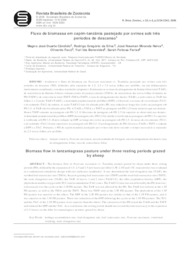Fluxo de biomassa em capim-tanzânia pastejado por ovinos sob três períodos de descanso.
Fluxo de biomassa em capim-tanzânia pastejado por ovinos sob três períodos de descanso.
Author(s): CÂNDIDO, M, J. D.; SILVA, R. G. da; NEIVA, J. N. M.; FACO, O.; BENEVIDES, Y. I.; FARIAS, S. F.
Summary: Resumo: Avaliou-se o fluxo de biomassa em Panicum maximum cv. Tanzânia pastejado por ovinos com três períodos de descanso (PD), definidos pela expansão de 1,5; 2,5 e 3,5 novas folhas por perfilho, em um delineamento inteiramente casualizado, com duas repetições (piquetes). Estimaram-se as taxas de alongamento de lâmina foliar total (TAlF), de senescência de lâminas foliares remanescentes do pastejo anterior (TSFA), de senescência das novas folhas formadas no PD (TSFP) e de senescência total (TSFT=TSFA+TSFP), a taxa de alongamento das hastes (TAlH), a razão entre as TAlF das folhas 1 e 2 (razão TAlF1/TAlF2), a densidade populacional de perfilhos (DPP), o filocrono e as taxas de crescimento (TCC) e de acúmulo (TAC) da cultura. A razão TAlF1/2 não foi afetada pelos PD, mas reduziu ao longo dos ciclos na pastagem sob PD 3,5. A TAlF não foi afetada pelos PD. A TAlH, a TSFA e a TSFT na pastagem sob PD 1,5 foram menores que nas demais. Houve TSFP somente na pastagem sob PD 3,5. O filocrono da pastagem sob PD 1,5 foi superior ao observado nas demais. A densidade populacional de perfilhos (DPP) da pastagem sob o PD 2,5 foi similar à verificada na pastagem sob PD 1,5 e superior à verificada sob PD 3,5. Houve redução na DPP ao longo dos ciclos na pastagem sob PD 3,5. As taxas de crescimento (TCC) e de acúmulo (TAC) foram superiores na pastagem sob PD 2,5. O prolongamento do PD elevou as TAlH e TSFT e reduziu a DPP e a TAC. Portanto, o PD do capim-tanzânia pastejado por ovinos não deve exceder o tempo necessário à expansão de 2,5 novas folhas por perfilho. [Biomass flow in tanzaniagrass pasture under three resting periods grazed by sheep]. Abstract: The biomass flow in Panicum maximum cv. Tanzânia pasture grazed by sheep under three resting periods (PD), defined by the expansion of 1.5; 2.5 and 3.5 new leaves per tiller (1.5F; 2.5F and 3.5F, respectively) was evaluated in a randomized completely design with two replicates (paddocks). It was determined the leaf elongation rate (TAlF), the residual leaf senescence rate (TSFA), the post-grazing leaf senescence rate (TSFP) and the total leaf senescence rate (TSFT), the stem elongation rate (TAlH), the TAlF of leaves 1 and 2 ratio (TALF1/2), the tiller population density (DPP), the phylochron and the crop growth (TCC) and accumulation (TAC) rates. The TAlF1/2 ratio was not affected by the PD, however, it decreased over the cycles at the 3.5F PD pasture. The TAlF was not affected by the PD. The TAlH was inferior at the 1.5F PD pasture, as well as the TSFA and the TSFT. There was TSFP only at the 3.5F PD pasture. The phylochron of the 1.5F PD pasture was superior to the others. The DPP of the 2.5F PD pasture was similar to that of the 1.5F PD pasture, and it was superior to the 3.5F PD pasture. There was reduction of the DPP following the cycles at the 3.5F PD pasture. The TCC and the TAC of the 2.5F PD pasture were superior than the others. The extension of the PD raised the TAlH and the TSFT and reduced the DPP and the TAC. As a conclusion, the resting period should not exceed the time necessary to the expansion of 2.5 leaves on the tiller for tanzaniagrass pastures grazed by sheep.
Publication year: 2006
Types of publication: Journal article
Unit: Embrapa Goats & Sheep
Observation
Some of Embrapa's publications are published as ePub files. To read them, use or download one of the following free software options to your computer or mobile device. Android: Google Play Books; IOS: iBooks; Windows and Linux: Calibre.
Access other publications
Access the Agricultural Research Database (BDPA) to consult Embrapa's full library collection and records.
Visit Embrapa Bookstore to purchase books and other publications sold by Embrapa.

